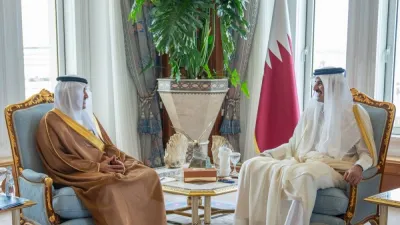Saudi Oil and Energy Minister Ali al-Naimi (right) and Finance Minister Ibrahim al-Assaf attending a cabinet session in Riyadh to approve the state’s budget for 2015. Saudi Arabia announced 2015 budget with a $38.6bn deficit due to sharp decline in oil prices, but still raised spending.
Reuters/Dubai
Saudi Arabia will lift state spending to a record in its 2015 budget while covering a deficit with its huge fiscal reserves, the government said, providing the first detailed look at how the world’s top oil exporter aims to handle an era of cheap oil.
Financial markets had feared the kingdom might slash spending. But the budget, released by the Finance Ministry yesterday, suggests authorities are confident of their ability to ride out low oil prices and see no need for major austerity.
Some analysts believe Riyadh is content to see oil prices fall as a way to squeeze out competing producers in non-Opec nations. The budget figures imply it could pursue this strategy for years if it felt that was necessary.
“The message of the budget is, ‘it’s business as usual’. They have the will and fiscal capacity to power the economy,” said John Sfakianakis, a former adviser to the Finance Ministry who is regional director of asset manager Ashmore in Riyadh.
Spending in the 2015 budget is projected at a record 860bn riyals ($230bn), up 0.6% from 855bn riyals in the 2014 budget plan — the smallest rise in over a decade.
Revenues are projected to drop to 715bn riyals in 2015 from 855bn riyals in the 2014 plan, leaving a deficit of 145bn riyals. That would be about 5.1% of the ministry’s estimate of the 2014 gross domestic product.
In the last six months, Brent crude oil has tumbled from around $115 a barrel — a level at which the kingdom was raking in giant budget surpluses — to just above $60.
But government reserves at the central bank, built up over the last four years of ultra-high oil prices, totalled 905bn riyals in October, enough to cover deficits of the size projected in 2015 for about six years. That excludes the government’s other assets and its ability to borrow.
Saudi Arabia will continue spending actively on economic development projects, social welfare and security despite the oil price slide and challenging conditions in the global economy, the ministry said.
That would be positive not only for Saudi Arabia but also for the rest of the Gulf, as Saudi money helps to drive the entire region, from the Dubai property market to Bahrain’s tourism industry and Kuwaiti construction firms.
As usual, Saudi Arabia did not reveal the oil price assumed in its budget. Monica Malik, chief economist at Abu Dhabi Commercial Bank, said it seemed to be assuming oil at $55 and Saudi output broadly unchanged at 9.5mn barrels per day.
“Saudi Arabia is in a strong position to fund its deficits...It could afford the new oil price for a year or even two,” she said, adding that if oil stayed low for longer, the government would probably have to start reining in spending.
Sections of the budget plan released to the public showed heavy spending on education, health and social welfare as well as state loans supporting job creation. Riyadh increased its focus on these areas after the 2011 Arab Spring uprisings showed the potential for instability in the region.
The budget statement did not give details of defence spending or aid to allied countries such as Egypt, but these are geopolitical priorities for Saudi Arabia so expenditure is expected to stay strong.
Many of the biggest infrastructure projects, such as a $22.5bn plan to build a metro rail system in Riyadh by 2019, are funded off-budget from a separate account and insulated from oil prices. That account contained 514bn riyals in October.
Saudi Arabia’s inflation-adjusted GDP grew an estimated 3.6% this year, up from 2.7% in 2013, the Finance Ministry said.
Growth may slow a little next year but Saudi Arabia will not come close to recession regardless of the oil price, Sfakianakis said, adding that very strong private sector activity would help to offset any slowdown in the oil sector.
Saudi Arabia’s actual state revenues and spending each year often differ greatly from its budget plans because of oil price fluctuations and policy adjustments.
The ministry said yesterday that actual revenues this year were now estimated at 1.046tn riyals and actual expenditure at 1.100tn riyals, leaving a 54bn riyal deficit, the first since the global financial crisis in 2009.



